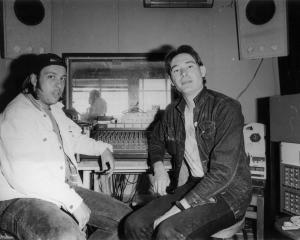
It's the magic of transforming a raw material into jewellery that has captured Antonia Boyle’s heart.
‘‘It’s the handmade aspect of it. Something about the labour of love, the amount of time and energy you spend physically working an object.’’
Ever since discovering jewellery during her first year at the Dunedin School of Art she has not stopped creating.
‘‘I‘ve always been creative. I knew I loved art, but I had no idea where I would go. I ended up falling in love with jewellery.’’
She likes the idea of making something a person will carry with them, something that has meaning for them or carries a message they want to convey.
‘‘The idea of a mobile piece of art is very attractive.’’
Boyle’s ‘‘day job’’ is manufacturing jewellery for Dunedin fashion designers Company of Strangers, which satisfies her craving for working with silver and precious materials.
In her own practice she tends to be a bit more experimental.

‘‘I really enjoy exploring different materials. I tend towards plastics. When I find a material I’m interested in, I push it as far as it can go, testing its limits, do all sorts of experiments and then I can find out exactly what I can do with it, how it will work with what I’m thinking of.’’
Her master’s degree project was a perfect example. She decided to use thermoplastic, a material that, to her knowledge, hadn’t been used for jewellery.
‘‘I had to figure it all out on my own, which took quite a while.’’
Thermoplastic captured her imagination as it is flexible.
‘‘They kind of do whatever you want them to, depending on how you treat it. The ability to colour it also made it very adaptable.’’
In her master’s project, she wanted to replicate native flowers and plants.
‘‘I was looking for a material that would allow me to do so many different things with it; so many different things in colour, shape and size.’’
Working with such different materials meant her jewellery tool kit has expanded to include non-traditional tools.

It was not an easy material to work with, especially when creating fine strands or needing to reheat it to make it malleable.
‘‘It kind of shrinks, creeps back on itself and gets thicker again, which is quite frustrating.’’
Boyle has been selected for the Handshake Project, a programme providing ongoing support for talented New Zealand art jewellery graduates.
The aim of the project is to help emerging jewellery artists develop skills that build upon a serious art practice. It includes mentoring feedback and professional development with an extensive exhibition programme.
Boyle chose Hanna Hedman as her mentor because she has always been drawn to the way Hedman’s work serves as a protective armour for the wearer while also appearing to grow from the body.
It dovetails with Boyle’s art which is inspired by the cyclical nature of life.
‘‘Within this cyclical nature, I am drawn to the way in which new life grows from the old, as the detritus of plants feeds new growth so can our losses feed our own personal growth.’’
She has been able to continue her work on that project at home during lockdown.
‘‘I’ve been playing with plants, bringing plants in to my work as well. Thinking about living plants in jewellery, how would that work and playing with some bone, more traditional materials, in that respect.
‘‘I’m very much in experiment mode trying everything under the sun. To see what grabs my attention. Some things are metal, some are bone, some are clay. It’s all very wild at the moment.’’
On occasion, she makes pieces on commission and says rings are the most popular.
‘‘They’re a nice everyday object.’’
She even ‘‘whipped up’’ a pair of lockdown earrings the other day.
‘‘I like quite big jewellery. I tend to wear big chains and earrings that are a little bit of a statement. There is usually a sentimental story behind them, pieces I’ve made or have been given to me and have a specific memory attached much like everyone else.
‘‘So much of what we want to portray to people is tied up in our jewellery and clothing. It’s a huge part of presenting a confidence. There are so many things jewellery can function as.’’
Boyle says the key to jewellery-making is being adaptable and being able to multi-task.
‘‘You have to be able to go from an arts piece to a piece from a production line where you have to do the same thing again and again.’’
Manufacturing jewellery for Company of Strangers has helped her improve her skills and her eye for detail.
‘‘I have such an eye for detail in my own work. When I’m doing production work, it’s very important to me that the work I’m doing for them accurately portrays their brand.
‘‘It’s a big part of my character, having an eye for detail rather than being a product of being a maker. I can be very particular about things sometimes.’’












